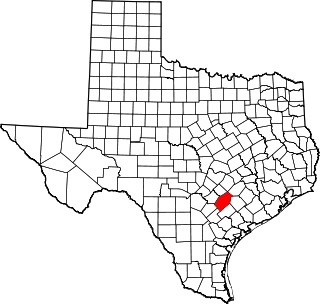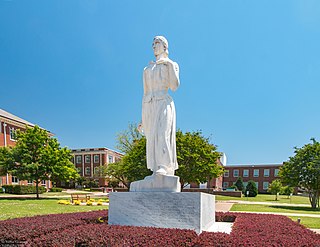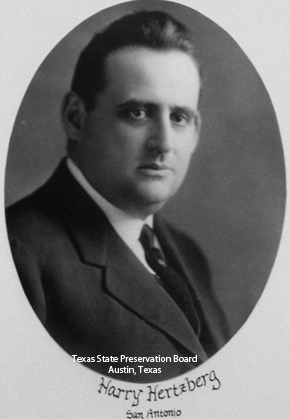
Gonzales County is a county in the U.S. state of Texas, adjacent to Greater Austin-San Antonio. As of the 2020 census, its population was 19,653. The county is named for its county seat, the city of Gonzales. The county was created in 1836 and organized the following year. As of August 2020, under strict budgetary limitations, the County of Gonzales government-body is unique in that it claims to have no commercial paper, regarding it as "the absence of any county debt."

Paul Philippe Cret was a French-born Philadelphian architect and industrial designer. For more than thirty years, he taught at a design studio in the Department of Architecture at the University of Pennsylvania.

Pompeo Luigi Coppini was an Italian born American sculptor. Although his works can be found in Italy, Mexico and a number of U.S. states, the majority of his work can be found in Texas. He is particularly famous for the Alamo Plaza work, Spirit of Sacrifice, a.k.a. The Alamo Cenotaph, as well as numerous statues honoring Texan figures, such as Lawrence Sullivan Ross, the fourth President of Texas A&M University.
Luis Alfonso JiménezJr. was an American sculptor and graphic artist of Mexican descent who identified as a Chicano. He was known for portraying Mexican, Southwestern, Hispanic-American, and general themes in his public commissions, some of which are site specific. The most famous of these is Blue Mustang. Jiménez died in an industrial accident during its construction. It was commissioned by the Denver International Airport and completed after his death.

The Texas Centennial half dollar was a commemorative fifty-cent piece struck by the United States Bureau of the Mint for collectors from 1934 to 1938. It features an eagle and the Lone Star of Texas on the obverse, while the reverse is a complex scene incorporating the winged goddess Victory, the Alamo Mission, portraits of Texan founding fathers Sam Houston and Stephen F. Austin, alongside the six flags over Texas. Proposed by the American Legion's Texas Centennial Committee as a fundraising measure for the Texas Centennial Exposition and a celebration of the hundredth anniversary of the Texas Revolution, the coin's issue was approved by Congress in 1933, ending a multi-year pause on new commemorative issues under the Hoover administration. It was designed by sculptor Pompeo Coppini, previously the designer of several Texan public monuments. Rough models of the coin were approved by the committee in May 1934, but rejected by the United States Commission of Fine Arts, who viewed the design as crowded and overly-complicated.

The Scottish Rite Cathedral of San Antonio, Texas is located at 308 Avenue E in San Antonio. Construction began on it in 1922 and was completed in 1924, at a cost of $1.5 million.

Brenda Putnam was an American sculptor, teacher and author.

Adina Emilia De Zavala was an American teacher, historian and preservationist of Texas history. Her efforts led to saving the Alamo Long Barrack Fortress for future generations. She was born to Augustine De Zavala, son of Lorenzo de Zavala, the first Vice President of the Republic of Texas. Adina's mother Julia Tyrrell De Zavala was born in Ireland. In 1994, Recorded Texas Historic Landmark Marker number 86 was placed at Alamo Plaza to honor De Zavala. In 2008, Texas Historical marker number 15124 was placed in St. Mary's Cemetery to honor De Zavala's contributions to Texas.

The Pioneer Woman statue is a work created by sculptor Leo Friedlander. It is located at the Texas Woman's University (TWU) in Denton, Texas, United States, and was commissioned as part of the Texas Centenary celebrations to mark the 100th anniversary of Texas Independence from Mexico. The sculpture was added to the National Register of Historic Places in 2018.

The Alamo Cenotaph, also known as The Spirit of Sacrifice, is a monument in San Antonio, Texas, United States, commemorating the Battle of the Alamo of the Texas Revolution, which was fought at the adjacent Alamo Mission. The monument was erected in celebration of the centenary of the battle, and bears the names of those known to have fought there on the Texas side.

Paul Richard Schumann was a Texas impressionist seascape painter who has been called the Gulf Coast counterpart of Winslow Homer.

Frank Teich was a German-born American sculptor, stone carver, and businessman, often referred to as the father of the Texas granite industry.
The National Association of Women Artists, Inc. (NAWA) is a United States organization, founded in 1889 to gain recognition for professional women fine artists in an era when that field was strongly male-oriented. It sponsors exhibitions, awards and prizes, and organizes lectures and special events.

George Washington Brackenridge was a philanthropist and the longest-serving Regent for the University of Texas. His donations of time, land holdings and wealth expanded the university and provided educational opportunities for women and other minorities. He was an advocate of women's suffrage and women's educational opportunities. He was also a business man who made his initial wealth as a profiteer during the Civil War. Brackenridge organized two banking institutions in San Antonio and served as their president. He was president of the San Antonio Water Works Company. Alamo Heights in Bexar County was once his residence and was named by him. His mansion Fernridge is now part of University of the Incarnate Word campus. Brackenridge Park, San Antonio Japanese Tea Garden and Mahncke Park in San Antonio were made possible through his donations of land holdings.

William Mozart McVey was an American sculptor, animalier and teacher.

A 1926–27 statue of George Washington by Italian American artist Pompeo Coppini was installed in northeast Portland, Oregon, United States. The bronze sculpture was the second of three statues of Washington by the artist, following a similar statue installed in Mexico City in 1912 and preceding another installed on the University of Texas at Austin campus in February 1955. The Portland statue was created to commemorate the 1926 sesquicentennial of the Declaration of Independence and dedicated in 1927. It was part of the City of Portland and Multnomah County Public Art Collection courtesy of the Regional Arts & Culture Council. In June 2020, it was toppled by protestors.

Bonnie MacLeary was an American sculptor. Some sources give her date of birth as 1890, 1892, or 1898.

Allie Victoria Tennant was an American sculptor born in St. Louis, Missouri, the daughter of Thomas Richard and Allie Virginia Brown Tennant. She worked primarily out of Dallas, Texas, where her most famous work Tejas Warrior was produced for the Hall of State at the Texas Centennial Exposition.

Harry Hertzberg was a prominent San Antonio lawyer, civic leader, and Texas state senator. Together with Tom Scaperlanda he donated the oldest public circus collection in the United States and one of the largest in existence originally to the San Antonio Public Library and now at the Witte Museum. He donated to the San Antonio Public Library almost 15,000 rare books.

James Duard Marshall was a painter, lithographer, museum director, and art conservator who lived most of his life in Kansas City. Duard [pronounced "doo-erd"] was a student of Thomas Hart Benton and is best known for his 30-foot mural created for the centennial of Neosho, Missouri in 1939. The civic leaders of Neosho had approached Benton to produce the mural, as Benton had been born in Neosho, but he suggested that his student Marshall do the job. That mural hangs in the Neosho Newton County Library.



















